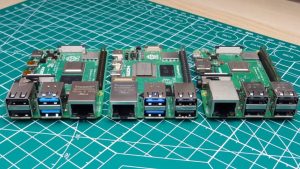
Raspberry Pi is a microcomputer based on ARM architecture, which has won the favor of developers worldwide with its credit card-sized size and powerful features. With the continuous advancement of technology, Raspberry Pi has also continued to release new versions, of which Raspberry Pi 4 and Raspberry Pi 5 are the latest versions of the series. In this article, we will delve into the hardware performance of Raspberry Pi 4 and Raspberry Pi 5, and help you better understand the advantages and disadvantages of these two products through data comparison.
I. Processor and Performance
The Raspberry Pi 4 uses a quad-core ARM Cortex-A72 processor with a clock speed of 1.5 GHz. After a firmware update, the clock speed was increased to 1.8 GHz. The Raspberry Pi 5 uses a quad-core 2.4 GHz Cortex-A76 processor, which provides more than twice the performance compared to the Raspberry Pi 4. This means that the Raspberry Pi 5 is more efficient at processing complex applications and tasks.
II. Memory and Storage
The Raspberry Pi 4 has 2GB or 4GB of RAM and supports up to 1TB of MicroSD card expansion. The Raspberry Pi 5 has 4GB or 8GB of RAM and supports up to 2TB of MicroSD card expansion. The larger memory capacity can support more tasks running simultaneously, improving overall performance. At the same time, the higher storage capacity is suitable for storing large amounts of data and large files.
III. Interface and connection
The Raspberry Pi 4 has four USB ports, one HDMI output, one Ethernet interface, one 3.5mm audio jack, and Wi-Fi and Bluetooth connectivity. The Raspberry Pi 5 adds more GPIO pins to the Raspberry Pi 4, providing more external device connectivity capabilities. In addition, it also supports faster USB 3.0 and advanced PCIe connectivity. The rich interface and connectivity features make the Raspberry Pi suitable for various application scenarios.
IV. Other Hardware Features
In addition to the above hardware specifications, Raspberry Pi 4 and Raspberry Pi 5 also have other hardware features. For example, they both have built-in real-time clocks, power buttons, and other practical functions. In addition, Raspberry Pi 5 also has more powerful video processing capabilities, supporting 4K video output and smoother gaming experience. These features make Raspberry Pi have higher performance in the fields of multimedia processing and gaming.
V. DYC ELECTRONIC SMD Factory
In the hardware manufacturing process, DYC ELECTRONIC SMT factory plays an important role. As a professional SMT processing manufacturer, our production line performs SMT processing in a high-quality, efficient and fast manner, providing customers with diversified PCBA, OEM/ODM finished product foundry services, as well as small-scale production. Whether you need samples or mass production, DYC ELECTRONIC SMT factory can provide you with professional SMT processing services to help you achieve reliability and efficiency improvement in hardware manufacturing.
Summary:
By comparing the hardware performance data of Raspberry Pi 4 and Raspberry Pi 5, we can see that both have improvements in terms of processor, memory, interface, and other hardware features. If you need higher performance and processing power, Raspberry Pi 5 is a better choice; if you have higher requirements for storage capacity and connectivity, Raspberry Pi 4 may be more suitable for you. Regardless of which product you choose, you can get powerful hardware performance and rich features to meet various application needs.
